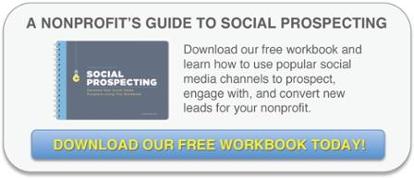
Even with so many content formats to choose from, nonprofit marketers all too often find themselves working within a limited scope of content because—lets’ face it—creating and maintaining a diverse content mix can be challenging.
While taking into consideration both strategy and effectiveness, consider expanding your content options to keep your marketing channels fresh and your community engaged.
To help you jumpstart some inspiration for your next editorial calendar, we’ve compiled a list of 25 content formats nonprofit marketers should consider using.
1. Social Media
Build audience relationships and connect with your community through a variety of social media platforms—Twitter, Facebook, LinkedIn, Pinterest, Instagram, and others. Social media is also a great channel to distribute content, including many of the formats found on this list.
2. Blog Posts
Blog content drives cause awareness, boosts organic search visibility, and builds thought leadership. Don’t miss out on a huge opportunity to increase your nonprofit’s visibility, digital reach, and ultimately donations. Consider launching a nonprofit blog if you don’t already have one.
3. Videos
As today’s most popular form of online content, video is a powerful marketing tool nonprofits can use to educate, inspire, and tell stories. Nonprofits can build a personal connection with their online communities through video marketing.
4. Photos
Great photos are the perfect complement to written content. Show off the faces of real people whose lives have been changed by your organization’s efforts, as well as those of your employees and volunteers who work tirelessly to fulfill your nonprofit's mission.
5. E-Newsletters
Despite the rise of social media, e-newsletters remain an effective tool in the nonprofit communication arsenal because they allow nonprofit marketers to easily build and maintain audience relationships, measure response rates, and link to other online marketing channels.
6. Case Studies
Case studies are a great vehicle for creating a narrative about the challenges your constituents face and how your nonprofit is at the forefront of change, leading others to join and support your cause.
7. Testimonials
Encourage your constituents to provide inspirational testimonials that tell their stories and describe their personal experiences with your nonprofit—delivered in their own words, from their perspective.
8. Quotes
Quotes can be used as a short-form method to reinforce your mission and other key messages. Embed powerful pull quotes within your content and format them for Twitter so readers can easily tweet them directly from your content. Or share them as stand-alone graphics that can be shared on other social media platforms like Instagram.
9. Interviews
While interviews may be an avenue to gather testimonials and quotes from constituents, volunteers, donors, and employees, you may also use them for gathering insight from cause leaders and influencers. These interviews can be incorporated into various content formats including blog posts and podcasts.
10. Landing Pages
Your nonprofit should be using landing pages to drive visitors to take specific actions (e.g., join our mailing list, donate, volunteer). Landing pages are particularly useful for promoting events and fundraising campaigns. Check out these tips to create an optimized landing page for your nonprofit.
11. Infographics
Infographics are one of the most shared and viewed content types. Use infographics to simplify complex information (e.g., cause research studies) by integrating words, graphics, and data into an easily digestible visual format.
12. Podcasts
Among their many benefits, podcasts offer yet another opportunity for nonprofits to educate, inform, inspire, and entertain audience members who prefer to consume their content while on the go.
13. Live Streaming Video
For events, special announcements, or just a periodic check-in, live streaming video tools like Facebook Live, Periscope, and Meerkat can help nonprofit marketers connect and engage in real-time with their online community.
14. Frequently Asked Questions (FAQs)
Dedicate an online hub to the most frequently asked questions (FAQs) from your community. These questions typically relate to your nonprofit’s cause, mission, leadership, volunteer opportunities, donations, financials, and more. FAQs can also be used as the foundation for "Did You Know?" content.
15. How-To Guides
Based on its high level of cause knowledge and experience, your nonprofit is uniquely qualified to create how-to guides that support your community members and offer them step-by-step instructions for completing a task or navigating a particular challenge.
16. News
Become a timely and relevant source of information by monitoring the latest cause-related news (including research) and reporting on the biggest stories that impact and resonate most with your community.
17. Surveys
Use surveys to collect research-based data and learn more about your community. Having a deeper understanding of your audience's thoughts and opinions can help you better tailor your content to their needs.
18. Quizzes
Use quizzes as a follow-up to "Did You Know?" content and FAQs. Quizzes are also a complement to webinars, as well as a great way to engage and educate your audience about your cause and organization.
19. Polls
Polls are valuable when it comes to obtaining audience opinions and feedback. Generate a poll when seeking community advice on a variety of topics including advocacy, events, fundraising, research, or even future content ideas.
20. Contests & Challenges
Social media contests and challenges are fun ways to attract new followers and boost excitement among your existing community. Similar to social media contests, challenges are viral in nature and have proven effective for raising cause awareness and donations. Remember the Ice Bucket Challenge? It raised over $80 million for ALS.
21. Twitter Chats
Twitter chats are an effective way to connect with followers on a consistent basis. Invite your audience to participate in a scheduled Twitter chat (using a designated chat hashtag) to ask or answer questions on a certain topic.
22. Memes
Nonprofit work is serious and occasionally somber, but that doesn’t mean you can’t lighten the mood from time to time. Share memes to show the fun side of your brand personality. That said, be sure to use discretion and sensitivity when injecting humor into your communications.
23. User Generated Content (UGC)
User generated content (UGC) engages and builds trust with audiences. Think of creative ways to get your audience to contribute to your content creation efforts. UGC ideas might come in the form of readers’ blog comments or community uploaded photos, videos, and personal stories.
24. Lists
From rankings to checklists, lists are one of the most popular content formats for blog posts—in fact, you’re reading one now. Lists can also help your audience follow a particular grouping, a sequence, or a step-by-step process to achieve a desired outcome.
25. Webinars
Nonprofits that provide training and/or courses for its members or volunteers should consider webinars. Webinars can help build your email list, as well as retain your existing email subscribers.
If your nonprofit is using content formats not included on this list, feel free to tell us about them in the comments below.
Download a free copy of our workbook to start finding new social media prospects for your nonprofit.


